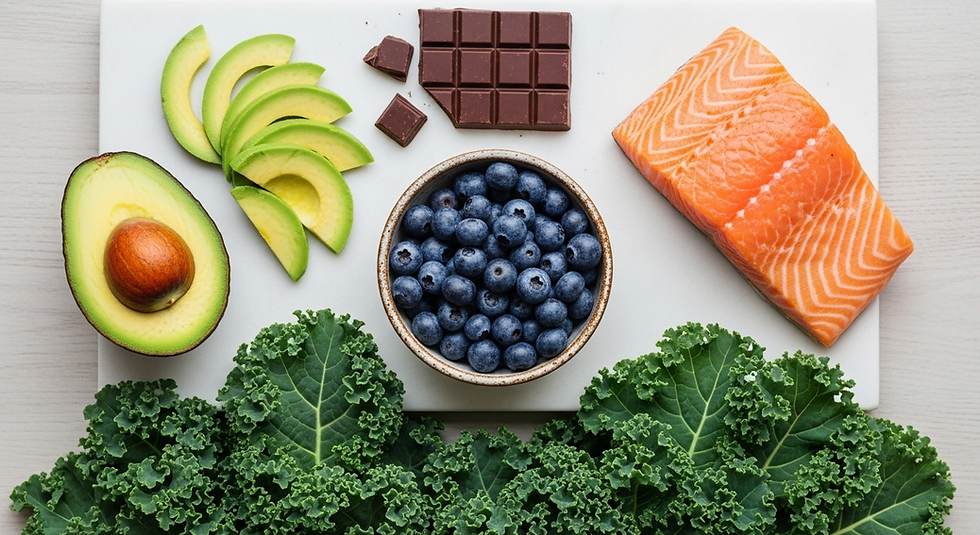The Top 5 Brain-Protecting Foods I Recommend
- Dr. Anisha Patel, PsyD

- Aug 22
- 6 min read

A simple, evidence-based guide to five powerful foods that can protect the brain from age-related decline

What you eat matters, especially for your gray matter. Feeding your brain is an act of self-respect and an investment in your future self—the version of you who can still show up fully, with clarity and vitality, in your 60s, 70s, and beyond years to come.
I've dedicated my career to understanding the intricate connection between what we eat and how we think. The idea that our brain can shrink over time is unsettling; poor nutrition can lead to measurable reductions in brain volume, particularly in the hippocampus, our hub for memory and learning.
Over time, you're not just losing focus; you're at risk of slowly losing parts of yourself. But the good news, which I find incredibly empowering, is that we have a significant degree of control. You don't need a complicated diet to start protecting your brain. I want to share five of my favorite foods that can help your brain stay sharp, focused, and young, along with easy ways I add them into my routine.
1. Blueberries (or "Brainberries")
Let's start with one of the most powerful and delicious brain-protective foods you can eat. I often call blueberries "brainberries" for a reason. They are packed with antioxidants that help reduce inflammation and oxidative stress, two of the primary drivers of cognitive decline.
These compounds directly support the brain areas responsible for memory, decision-making, and focus. Research has shown that consistent intake can slow brain aging and improve cognitive performance, especially in older adults. But the benefits aren't just for later in life; the earlier you start, the more resilient your brain becomes over time.
Brain-Friendly Alternative: If blueberries aren't your favorite, you can easily swap them for blackberries or raspberries. They are from the same family and offer similar protective benefits.
How I Eat Them: I toss a handful into my morning smoothie, stir them into Greek yogurt, or even eat them frozen as a quick, refreshing snack. Just one handful a day goes a long way.
The flavonoids found in berries have been shown to cross the blood-brain barrier and accumulate in brain regions important for learning and memory, such as the hippocampus.

2. Avocados
Your brain absolutely loves healthy fats, and avocados are one of the best sources. They are full of monounsaturated fats, which are vital for healthy blood flow and reducing inflammation in the brain. Better blood flow means more oxygen and nutrients are delivered to your brain cells. From my experience, this translates to better mental clarity, faster processing speed, and more sustained cognitive energy throughout the day.
Brain-Friendly Alternative: If avocados aren't in season or to your liking, extra virgin olive oil is a fantastic alternative, rich in the same brain-healthy monounsaturated fats.
How I Eat Them: I often enjoy half an avocado with a sprinkle of sea salt and a squeeze of lemon juice as a snack. You can also mash it on whole-grain toast or make extra virgin olive oil your go-to dressing for salads and roasted vegetables.
Monounsaturated fats, like those in avocados and olive oil, are a key component of the Mediterranean diet, which is consistently linked to better cognitive function and a lower risk of dementia.

3. Wild Salmon
Your brain is composed of about 60% fat, making it the fattiest organ in your body. Wild salmon is one of the richest natural sources of the omega-3 fatty acids DHA and EPA. These aren't just any fats; they are the literal building blocks for your brain cells. They support the structure of your cell membranes, improve communication between neurons, and powerfully reduce inflammation linked to mood changes and memory decline. Individuals who regularly consume omega-3 fatty acids have been shown to exhibit better cognitive function and even larger brain volumes.
Brain-Friendly Alternative: If fish isn't your thing, you can get these brain-friendly fats from chia seeds, walnuts, and flax seeds.
How I Eat Them: I aim to have grilled or baked salmon once or twice a week, often with lemon and herbs. On other days, I’ll toss a tablespoon of chia seeds or a handful of walnuts into my smoothie or yogurt.
DHA, the omega-3 fatty acid abundant in wild salmon, makes up about 30% of the fatty acids in the brain's cerebral cortex.

4. Dark Chocolate
Yes, chocolate made the list, but with an important distinction: we're talking about dark chocolate with at least 70% cacao. It contains potent antioxidants called flavonoids, which have been shown to increase blood flow to the brain. This can support sharper focus and quicker reaction times. It also provides a gentle boost to dopamine, our "motivation molecule," which helps you stay engaged during long work sessions.
Brain-Friendly Alternative: If you're not into dark chocolate, green tea—or my personal favorite, matcha—is a great choice. Matcha gives you a concentrated dose of brain-boosting antioxidants and L-theanine for calm, focused energy. Just be mindful of added sugars in café versions and always check the label for pure matcha powder.
How I Use Them: I enjoy a couple of squares of dark chocolate as an afternoon brain snack or sip on a matcha tea before a deep work session. If you're sensitive to caffeine like me, it's best to enjoy these earlier in the day.

5. Leafy Greens
Spinach, kale, Swiss chard, and arugula are nutritional powerhouses for your brain. Leafy greens are packed with crucial brain nutrients like folate, vitamin K, and lutein, all of which directly support long-term cognitive health. In fact, one incredible study showed that people who ate just one serving of leafy greens daily had brains that functioned as if they were more than a decade younger than those who didn't.
Brain-Friendly Alternative: If you're not a fan of salads, broccoli and brussels sprouts are also green, nutrient-dense vegetables packed with brain-boosting compounds.
How I Eat Them: This is one of the easiest to incorporate. I toss a large handful of spinach into my morning eggs or blend it into smoothies—you won't even taste it. I also try to build my lunch or dinner around a hearty salad. Roasting broccoli or brussels sprouts with olive oil and garlic is another delicious way to get them in.
A study from Rush University found that participants who ate at least one serving of leafy green vegetables a day had a slower rate of cognitive decline, equivalent to being 11 years younger in brain age.

Summary
Protecting your brain for the long term doesn't require a radical overhaul of your life. The key is consistency. By starting with just one of these five foods and building from there, you can create small, sustainable habits that make a big difference over time. Every meal becomes an opportunity to nourish your brain, protect your future, and show up as your sharpest, most present self.
What you eat matters, especially for your gray matter. I truly believe that feeding your brain is an act of self-respect and an investment in your future self—the version of you who can still show up fully, with clarity and vitality, in your 60s, 70s, and beyond. You'll remember more, stay focused longer, and feel more emotionally steady. Start today. Your brain will thank you for years to come.
Frequently Asked Questions
Does it matter if the berries are fresh or frozen?
Not at all! Frozen berries are picked at peak ripeness and flash-frozen, which preserves their nutrients. They are a fantastic and often more affordable option for smoothies and yogurt.
Is farmed salmon as good as wild salmon?
Wild salmon is generally preferred as it has a higher concentration of omega-3s and fewer contaminants. However, if farmed salmon is your only option, it is still a better source of omega-3s than no salmon at all.
How much dark chocolate is okay to eat daily?
Moderation is key due to its calorie density and caffeine content. One to two small squares (about 1 ounce or 30 grams) is a perfect amount to get the benefits without overdoing it.
I don't like vegetables. How can I really get leafy greens in?
Blending spinach into a fruit smoothie is the ultimate hack—it completely masks the taste. You can also finely chop greens and mix them into sauces, soups, or casseroles.
If I could only pick one of these foods to start with, which is best?
While they all offer unique benefits, leafy greens are arguably one of the easiest and most impactful to add daily. The research linking a single daily serving to a brain that's 11 years younger is incredibly compelling.
About Dr. Anisha Patel, PsyD
My extensive research and expertise in cognition form the robust psychological foundation for our innovative cognitive strategies. At BioLife Health Research Center, I am passionate about applying scientific research to real-world problems. I strive to bridge the gap between theory and practice. My commitment to improving human performance through cognitive tools makes me a valuable asset to our team as we work together to empower individuals to reach their full potential.



